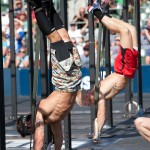 The Fit As F*ck blog has a great little interview series going that hits the topic of random vs. structured training in CrossFit. I’ve been thinking about this a lot as I’ve begun to compete and my own training has diversified in the last few months. I thought I’d use their format and blog my perspective on the subject. Be sure to read the original posts with Samantha Briggs and Asger Frøsig Sørensen.
The Fit As F*ck blog has a great little interview series going that hits the topic of random vs. structured training in CrossFit. I’ve been thinking about this a lot as I’ve begun to compete and my own training has diversified in the last few months. I thought I’d use their format and blog my perspective on the subject. Be sure to read the original posts with Samantha Briggs and Asger Frøsig Sørensen.
My training plan for 2012
I started on a new plan that has me doing regular CrossFit 2 times per week, but those sessions also have a Wendler strength component. I do Olympic Lifting at another gym 2x week, and then see a strength coach 2x week. I actually go to three different gyms each week! The Oly lifting and strength is highly structured while the CrossFit, obviously, is random.
Where I get my inspiration from
I’m inspired and pushed by the athletes at my CrossFit gym. I treat CrossFit as a sport and thus I’m always competing against (and with) my teammates in a positive way.
Future goals:
Increase my strength a lot and then have the capacity to compete in the RX division of some of the larger competitions in my region. Right now strength is my “weakness” so I’m spending a good part of 2012 changing that.
Thoughts on random vs. structured CrossFit training
I think Asger nailed this question in his inteview. I’ll give my two cents.
For regular folks who want to get fit and have no aspirations to compete, or compete only casually, regular CrossFit WODs are perfect. You can supplement that with playing sports or surfing or biking or whatever else you like to do and it works great.
I approach CrossFit as a sport unto itself and thus I’m interested in going to competitions and performing at a high level. I think there’s no question that in order to keep up, you have to add in other forms of structured training. This could be a system like the Limited Conjugated Method by Rudy Nielsen, or a simpler linear strength program you can find online. Put another way, if you just do the Rx WOD at your box, you will almost certainly not be prepared to compete and get good results.
What I’ve noticed, and maybe someone more experienced than I can chime in, is there’s an arms race among competitions to incorporate bigger and badder WODs. Heavier loads, crazier movements, more weird tasks, etc. So there’s a disconnect between run-of-the-mill box programming and competition programming, and athletes need to be proactive about finding resources to get themselves prepared.
For the record, I love sick WODs and I’m all for bigger and badder. Let’s push the limits.
Thoughts on CrossFit boxes offering more personalized training
Ideally, boxes would have intermediate and advanced tracks, and perhaps even a “High Performance” track if you have enough athletes to sustain it. High Performance would be programming for elite and pre-elite competitors.
Beyond that, I’d love to see gyms incorporate starting strength and Olympic lifting classes. There are business issues with having diversified programming, so it’s tricky for box owners.
What I’ve seen in my community is that the serious CrossFitters are finding ways to get additional training in, either by taking a class at another gym, building a garage gym, working out on their own, or hiring another coach. So the need is clearly there.
I think what you’ll start to see in the future are CrossFit camps and clubs popping up around the country, where athletes go to train for a couple of weeks (or longer) under elite coaches. It’s common in other sports like running and rowing to move to a new city just to train. As more CrossFitters edge into professionalism, you’ll see athletes moving around also.
